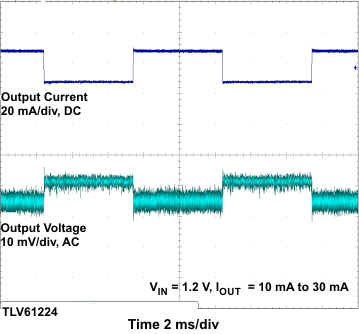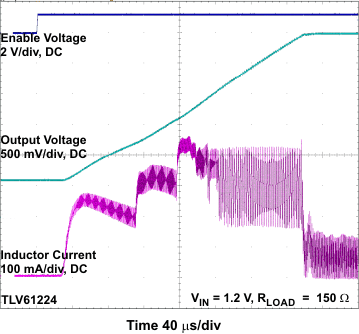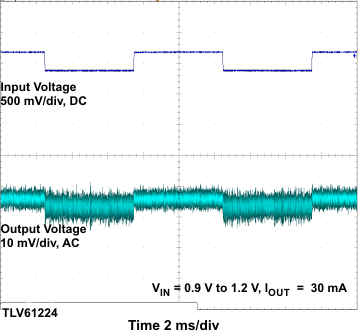SLVSAM7A March 2011 – May 2015 TLV61224
PRODUCTION DATA.
8 Application and Implementation
NOTE
Information in the following applications sections is not part of the TI component specification, and TI does not warrant its accuracy or completeness. TI’s customers are responsible for determining suitability of components for their purposes. Customers should validate and test their design implementation to confirm system functionality.
8.1 Application Information
The TLV61224 device is intended for systems which are powered by a single-cell battery to up to two Alkaline, NiCd, or NiMH cells with a typical terminal voltage from 0.7 V to 3 V and can output 3-V voltage. Additionally, any other voltage source with a typical output voltage from 0.7 V to 3 V can be used with the TLV61224 device.
8.2 Typical Application
 Figure 8. Typical Application Schematic
Figure 8. Typical Application Schematic
8.2.1 Design Requirements
In this example, TLV61224 device is used to design a 3-V power supply with up to 15-mA output current capability. The TLV61224 device can be powered by a single-cell battery to up to two Alkaline, NiCd, or NiMH cells with a typical terminal voltage from 0.7 V to 3 V. The input voltage range is from 0.8 V to 1.5 V for single-cell Alkaline battery input design.
8.2.2 Detailed Design Procedure
8.2.2.1 Programming the Output Voltage
At fixed voltage versions, the output voltage is programmed by an internal resistor divider. The FB pin is used to sense the output voltage. To configure the devices properly, the FB pin must be connected directly to VOUT.
8.2.2.2 Inductor Selection
To make sure that the TLV61224 devices can operate, a suitable inductor must be connected between pin VIN and pin L. Inductor values of 4.7 μH show good performance over the whole input and output voltage range.
Due to the fixed inductor current ripple control the switching frequency is defined by the inductor value. For a given switching frequency, input and output voltage the required inductance can be estimated using Equation 1.

Using inductor values greater than 4.7 μH can improve efficiency because greater values cause lower switching frequency and less switching losses. TI does not recommend using inductor values less than 2.2 μH.
To ensure reliable operation of the TLV61224 device under all load conditions, TI recommends using inductors with a current rating of 400 mA or higher. This will cover normal operation including current peaks during line and load transients.
Table 2 lists the inductor series from different suppliers that have been used with the TLV61224 converter:
Table 2. List of Inductors
| VENDOR | INDUCTOR SERIES |
|---|---|
| Coilcraft | EPL3015 |
| EPL2010 | |
| Murata | LQH3NP |
| Tajo Yuden | NR3015 |
| Wurth Elektronik | WE-TPC Typ S |
8.2.2.3 Capacitor Selection
8.2.2.3.1 Input Capacitor
TI recommends at least a 10-μF input capacitor to improve transient behavior of the regulator and EMI behavior of the total power supply circuit. TI recommends placing a ceramic capacitor as close as possible to the VIN and GND pins of the IC.
8.2.2.3.2 Output Capacitor
For the output capacitor C2, TI recommends placing small ceramic capacitors as close as possible to the VOUT and GND pins of the IC. There are no minimum output capacitor ESR requirements for maintaining control loop stability. If, for any reason, the application requires the use of large capacitors which cannot be placed close to the IC, TI recommends using a small ceramic capacitor with a capacitance value in the range of 2.2 μF in parallel to the large capacitor. This small capacitor should be placed as close as possible to the VOUT and GND pins of the IC.
A minimum capacitance value of 4.7 μF should be used; TI recommends a value of 10 μF. Use Equation 2 to calculate the required output capacitance in case an inductor with a value greater than 4.7 μH has been selected.

8.2.3 Application Curves
 Figure 9. Load Transient Response
Figure 9. Load Transient Response
 Figure 11. Start-Up After Enable
Figure 11. Start-Up After Enable
 Figure 10. Line Transient Response
Figure 10. Line Transient Response
Table 3 lists the components used for the waveform measurements.
Table 3. List of Components:
| COMPONENT REFERENCE | PART NUMBER | MANUFACTURER | VALUE | |
|---|---|---|---|---|
| C1 | GRM188R60J106ME84D | Murata | 10 μF, 6.3 V | |
| C2 | GRM188R60J106ME84D | Murata | 10 μF, 6.3 V | |
| L1 | EPL3015-472MLB | Coilcraft | 4.7 μH | |